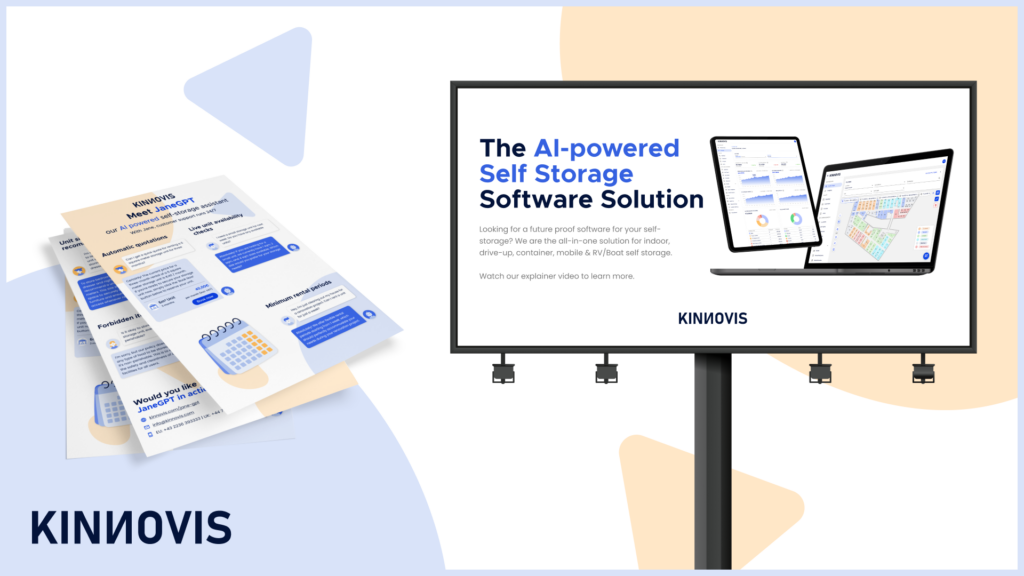
How to Measure the Success of Traditional Self-Storage Marketing
The Role of Traditional Marketing in Self-Storage
For digital marketing campaigns, like Google Ads, SEO and Email, discovering how successful they’ve been in delivering you new customers and the return on your investment (ROI) from your marketing spend is relatively easy to determine. Providing you have your accounts and web tracking set up correctly, you can almost see every step a user takes in becoming your next customer.
Where tracking becomes tricky
Where things get slightly trickier is when you want to measure the success of offline marketing campaigns. You may have invested heavily in facility signage, local flyer drops, community sponsorships or perhaps even TV advertising – but do you know what kind of impact that spend has had on your bottom line?
One simple approach would be, when it comes to reporting on your marketing performance, to add the costs of your traditional marketing to your digital spend. The theory being that, yes, they clicked on an ad after searching for your self-storage facility, but they may have seen or heard about your brand name on a billboard or in a newsletter to know what to search for in the first place. Therefore, your traditional marketing had a part to play in bringing that customer onboard.
The downside to this approach, however, is that it doesn’t give you much insight to use for your next campaign. Should you increase the radius of your next flyer drop? Would some additional signage help to better sell your service? Or, is it time to drop your sponsorship of the local village sports team?
Measuring the unmeasurable: Medium difficulty
For insights about the impact of your marketing from tools you may already have, or could set up easily, here are some metrics you can learn from.
Recent reservations. An overall spike in bookings and new customers will certainly tell you that you’re on the right track with your marketing campaigns, but if you’re using a self-storage software manager, you should have extra details on your recent conversions. Perhaps you had a wave of new customers, but they’re from a different side of town to your new billboard. A deeper understanding of your customers will help you better attribute who likely did and didn’t sign-up because of certain marketing decisions.
Website traffic. You don’t only have to look at who has booked. With tools like Google Analytics, you can see your website volume as well as any spikes in traffic coming from regions and specific areas you may have targeted with some recent traditional marketing campaigns.
“How did you hear about us?”. A mainstay in marketing forms and sales calls, asking a newly acquired customer how they heard about you at the point where they’re ready to convert. This common question is used in most industries, not just self-storage and it can lead to some valuable insights. There are some limitations in this line of questioning, however: they may not truthfully remember and give you a false answer or there could have been multiple times that they came across your company before reaching out to you. If you only give people the option to choose one answer, they’ll likely only pick the most recent form of marketing and most likely going to be some form of digital marketing.
Measuring the unmeasurable: Advanced settings
If you’re looking for a more definitive cut-through from your traditional marketing, there are a few more advanced options that will give you objective insights and a more concrete ROI.
Unique discount codes. By including a coupon or special offer on any print advertising, like flyers, you’ll be able to track how many customers redeem it when they visit your facility. Additionally, if you measure the time between the delivery of your print marketing and the final time a coupon was redeemed, it will give you an idea of how long people hold onto your marketing and how routinely you should be sending out mailers.
QR Codes. By using QR codes effectively in your traditional marketing campaigns, you can make it easier for potential customers to access relevant information and promotions while also gaining insights into the performance of each campaign element. Generating a different code for each campaign will also allow you to compare the engagement levels of your various marketing ventures.
Unprompted surveys. There are survey operators, like SurveyMonkey and Pollfish, that you can pay to anonymously collect survey responses from your target demographic for you. The approach would be to survey a group of people before you launch your marketing campaign and then a different group afterwards, and then compare results. Some questions you could ask are:
- How many self-storage brands could you name?
- Which of these companies have you heard of? [List your brand and some competitors]
- [For those that selected your brand] How did you hear about this company?
The benefit of this approach is that you’re not looking at the potentially biased responses of your customers but instead seeing a clear measure of how awareness of your brand has changed as a result of your marketing activities.
Conclusion
With self-storage being a needs-based industry, the timing of your marketing can be crucial. Google ads and digital marketing can be a way to promote your business at the point when people need storage but it’s a congested space, filled with competition and can be expensive to maintain. Traditional marketing, along with your digital campaigns, can massively improve the brand awareness of your self-storage business and reduce your overall cost per acquisition, if it can prompt someone to go directly to your website instead of Google. By adopting some of the above measures of success, you’ll soon learn which marketing avenues work best for you.
